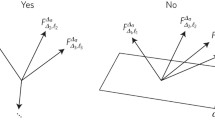Abstract
The applicability conditions of a recently reported Central Limit Theorem-based approximation method in statistical physics are investigated and rigorously determined. The failure of this method at low and intermediate temperature is proved as well as its inadequacy to disclose quantum criticalities at fixed temperatures. Its high temperature predictions are in addition shown to coincide with those stemming from straightforward appropriate expansions up to (k B T)−2. Our results are clearly illustrated by comparing the exact and approximate temperature dependence of the free energy of some exemplary physical system.

Similar content being viewed by others
Notes
The third low can be violated only for systems whose ground state degeneracy grows exponentially with the number of blocks.
References
Abramowitz, M., Stegun, I.A.: Handbook of Mathematical Functions. Dover, New York (1970), p. 298, Sect. 7.1.13
Barouch, E., McCoy, B.M., Dresden, M.: Statistical mechanics of the XY model. I. Phys. Rev. A 2, 1075–1092 (1970). For a modern formulation of the problem, see for example Iorgov, N., Shadura, V., Tykhyy, Y.: Spin operator matrix elements in the quantum Ising chain: fermion approach. J. Stat. Mech. P02028 (2011)
Bruus, H., Flensberg, K.: Many-Body Quantum Theory in Condensed Matter Physics. Oxford University Press, Oxford (2007)
Campisi, M., Talkner, P., Hänggi, P.: Thermodynamics and fluctuation theorems for a strongly coupled open quantum system: an exactly solvable case. J. Phys. A, Math. Theor. 42, 392002–392014 (2009)
Cat, D.T., Pucci, A., Wandelt, K.: Physics and Engineering of New Materials. Springer Proc. Physics. Springer, Berlin (2009)
Fisher, M.E.: Renormalization group theory: its basis and formulation in statistical physics. Rev. Mod. Phys. 70, 653–681 (1998)
Gogolin, C., Müller, M.P., Eisert, J.: Absence of thermalization in nonintegrable systems. Phys. Rev. Lett. 106, 040401–040404 (2011)
Goldenfeld, N.: Lectures on Phase Transitions and the Renormalization Group. Perseus Book Publ., Reading (1992)
Greiner, M., Mandel, O., Esslinger, T., Hänsch, T.W., Bloch, I.: Quantum phase transition from a superfluid to a Mott insulator in a gas of ultracold atoms. Nature 415, 39–44 (2002)
Hartmann, M., Mahler, G., Hess, O.: Spectral densities and partition functions of modular quantum systems as derived from a central limit theorem. J. Stat. Phys. 119, 1139–1151 (2005)
Hartmann, M., Mahler, G., Hess, O.: Gaussian quantum fluctuations in interacting many particle systems. Lett. Math. Phys. 68, 103–112 (2004)
Hartmann, M., Mahler, G., Hess, O.: Local versus global thermal states: correlations and the existence of local temperatures. Phys. Rev. E 70, 066148–066159 (2004)
Hartmann, M., Mahler, G., Hess, O.: Existence of temperature on the nanoscale. Phys. Rev. Lett. 93, 080402–080405 (2004)
Hata, K., Futaba, D.N., Mizuno, K., Namai, T., Yumura, M., Iijima, S.: Water-assisted highly efficient synthesis of impurity-free single-walled carbon nanotubes. Science 306, 1362–1364 (2004)
Kubo, R.: Thermodynamics. North-Holland, Amsterdam (1968)
Lieb, E., Schultz, T., Mattis, D.: Two soluble models of an antiferromagnetic chain. Ann. Phys. 16, 407–466 (1961)
Prokof’ev, N.V., Stamp, P.C.E.: Theory of the spin bath. Rep. Prog. Phys. 63, 669–726 (2000)
Rançon, A., Dupuis, N.: Nonperturbative renormalization group approach to the Bose-Hubbard model. Phys. Rev. B 83, 172501–172504 (2011)
Sachdev, S.: Quantum Phase Transitions. Cambridge University Press, Cambridge (2008)
Sadler, L.E., Higbie, J.M., Leslie, S.R., Vengalattore, M., Stamper-Kurn, D.M.: Spontaneous symmetry breaking in a quenched ferromagnetic spinor Bose condensate. Nature 443, 312–315 (2006)
Smacchia, P., Amico, L., Facchi, P., Fazio, R., Florio, G., Pascazio, S., Vedral, V.: Statistical mechanics of the cluster-Ising model. quant-ph/1105.0853v2 (2011)
Suenaga, K., Koshino, M.: Atom-by-atom spectroscopy at graphene edge. Nature 468, 1088–1090 (2010)
Vidal, G.: Entanglement renormalization. Phys. Rev. Lett. 99, 220405–220408 (2007)
Werpachowska, A.: Exact and approximate methods of calculating the sum of states for noninteracting classical and quantum particles occupying a finite number of modes. Phys. Rev. E 84, 041125–041132 (2011)
Acknowledgements
OL acknowledges the partial support from grants NSh-4172.2010.2, RFBR-11-02-00778, RFBR-10-02-01398 and from the Ministry of Education and Science of the Russian Federation under contracts No. 02.740.11.0239.
Author information
Authors and Affiliations
Corresponding author
Rights and permissions
About this article
Cite this article
Leggio, B., Lychkovskiy, O. & Messina, A. On the Merit of a Central Limit Theorem-based Approximation in Statistical Physics. J Stat Phys 146, 1274–1287 (2012). https://doi.org/10.1007/s10955-012-0442-9
Received:
Accepted:
Published:
Issue Date:
DOI: https://doi.org/10.1007/s10955-012-0442-9




